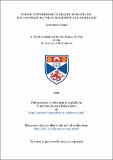Files in this item
Ethnic differences in health in Scotland : the contrast between morbidity and mortality
Item metadata
| dc.contributor.advisor | Finney, Nissa | |
| dc.contributor.advisor | Kulu, Hill | |
| dc.contributor.advisor | Marshall, Alan | |
| dc.contributor.author | Cezard, Genevieve | |
| dc.coverage.spatial | xiv, 249 p. | en_US |
| dc.date.accessioned | 2020-03-02T15:48:15Z | |
| dc.date.available | 2020-03-02T15:48:15Z | |
| dc.date.issued | 2020-06-24 | |
| dc.identifier.uri | https://hdl.handle.net/10023/19578 | |
| dc.description.abstract | In Scotland, most minority ethnic groups live longer than the White Scottish population but whether they report better health is unclear. Similarly, the international literature on ethnicity and health is divided between a strand that highlights the overall morbidity disadvantage in ethnic minorities and another strand that is puzzled by their mortality advantage. This thesis brings the two strands together by investigating whether ethnic patterns in morbidity and mortality align, based on a unique population source. The Scottish Health and Ethnicity Linkage Study links the Scottish Census 2001 to 12 years of hospitalisation and death records and provides a considerable sample size (4.6 million people) for this research. Therefore, this thesis makes a number of methodological contributions in addition to providing key empirical evidence of an ethnic morbidity-mortality paradox in Scotland. In particular, healthy life expectancy by sex and ethnicity is calculated for the first time in the UK using a direct method. Findings highlight the shortest healthy life expectancies in the Pakistani population contrasting with their mortality advantage. Hence, the Pakistani population experiences the highest number of years in poor health in Scotland. Indeed, the Pakistani population reports poorer health than the majority population which contrasts with their mortality advantage. This contrast persists beyond socio-economic circumstances and across migrant generations. Furthermore, using interaction analyses, this research demonstrates that reporting poorer health strongly predicts higher risks of mortality in minority ethnic groups but with greater strength for particular groups. Finally, findings show higher risks of (hospitalisation-based) multimorbidity in the Pakistani population which supports their morbidity disadvantage in Scotland. Diseases underlying this disadvantage include those related to the metabolic syndrome and respiratory disease. Policy makers should aim to improve the quality of life of the Pakistani population of Scotland while future research pinpoints the root causes of this morbidity-mortality paradox. | en_US |
| dc.language.iso | en | en_US |
| dc.publisher | University of St Andrews | en |
| dc.subject | Ethnicity | en_US |
| dc.subject | Morbidity | en_US |
| dc.subject | Mortality | en_US |
| dc.subject | Scotland | en_US |
| dc.subject | Health inequalities | en_US |
| dc.subject.lcc | RA418.5T73C4 | |
| dc.subject.lcsh | Ethnic groups--Health and hygiene--Scotland | en |
| dc.subject.lcsh | Minorities--Health and hygiene--Scotland | en |
| dc.subject.lcsh | Health--Social aspects--Scotland | en |
| dc.subject.lcsh | Mortality and race--Scotland | en |
| dc.subject.lcsh | Pakistanis--Health and hygiene--Scotland | en |
| dc.title | Ethnic differences in health in Scotland : the contrast between morbidity and mortality | en_US |
| dc.type | Thesis | en_US |
| dc.contributor.sponsor | University of St Andrews. School of Geography and Sustainable Development. St Leonard’s and Geography & Sustainable Development PhD studentship | en_US |
| dc.type.qualificationlevel | Doctoral | en_US |
| dc.type.qualificationname | PhD Doctor of Philosophy | en_US |
| dc.publisher.institution | The University of St Andrews | en_US |
| dc.identifier.doi | https://doi.org/10.17630/10023-19578 |
This item appears in the following Collection(s)
Items in the St Andrews Research Repository are protected by copyright, with all rights reserved, unless otherwise indicated.

